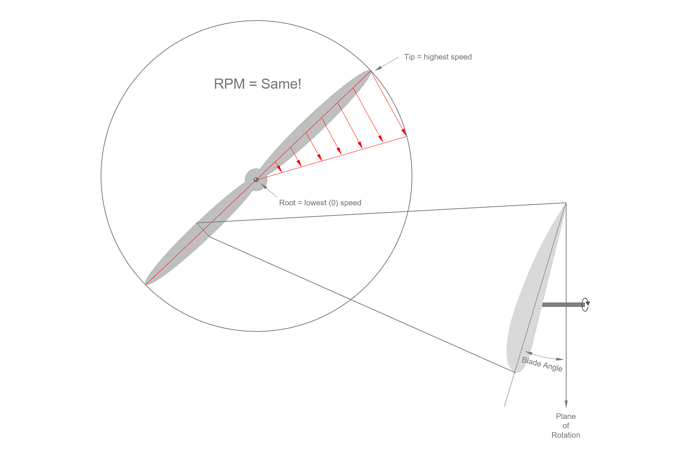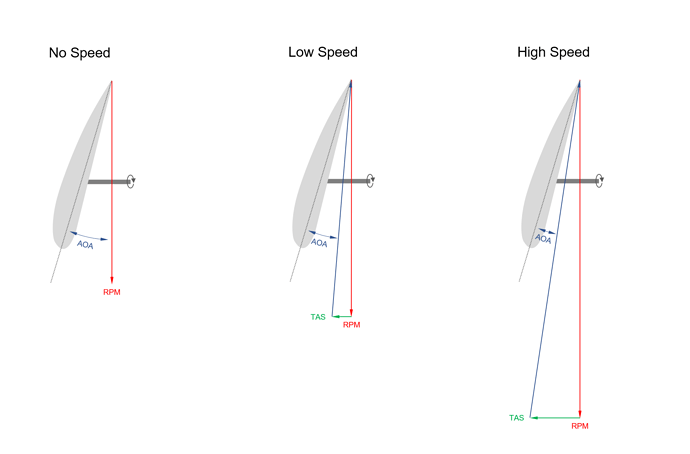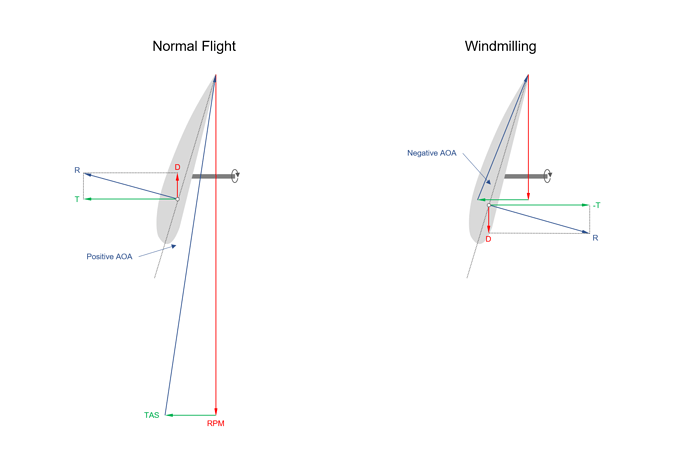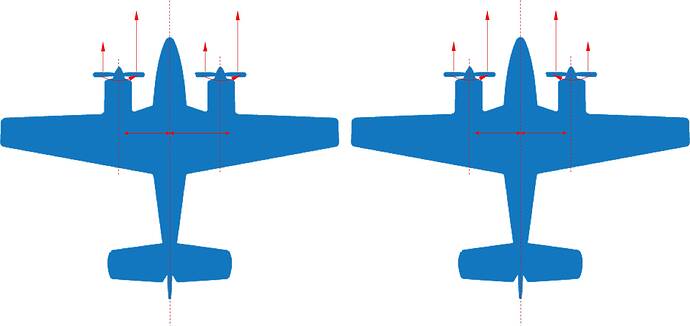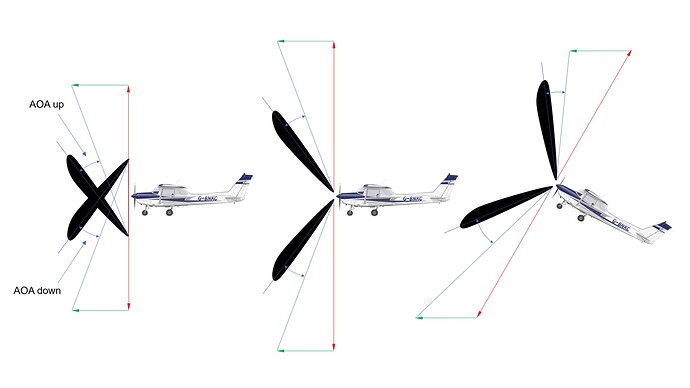Definitions
First it is important to understand the following definitions when talking about propellers:
- Blade / Pitch angle - This is the angle between the propeller plane of rotation and the chord line of the blade. On a fixed pitch propeller this angle is fixed, on a Constant Speed Propeller (CSP), this angle is adjusted to balance engine power and propeller power absorbed, controlling the propeller RPM.
- Washout or twist - The blade angle on a propeller blade is not the same along the whole range of the propeller, as the propeller rotates, the root of the propeller has a lower tangential velocity when compared to the tip of the propeller (compare this with a baseball bat, the tip of the baseball bat has a higher velocity compared to the root). In order to have the same angle of attack on the whole propeller blade the blade angle on the tip is lower than on the root (twist or washout).
- Windmilling - Is the condition describing the propeller rotating by the forward speed of the aircraft rather than by absorbing power by the engine. When a propeller is said to be windmilling, the propeller is driving the engine instead of the engine driving the propeller. Windmilling is caused by a negative angle of attack on the propeller blade, essentially producing negative thrust (drag). You can look at it as a thrust reverse without having a negative blade angle. The windmilling RPM of a propeller is depending on the drag from the engine (in that regard the devs. are right) and aircraft forward airspeed (TAS). Lower RPM = lower drag, higher RPM = higher drag.
- Forces - There are a lot of forces acting on a propeller, we will be looking at Lift (thrust) and Drag, the rest of the forces are of importance when trying to understand constant speed propellers. Centrifugal Twisting Moment (CTM), Aerodynamic Twisting Moment (ATM), centrifugal (feathering) weights added to the propeller, springs in the propeller hub etc. we will skip those for now.
- Fine & Coarse Pitch - On a constant speed propeller the blade angle is variable, a small blade angle is called “fine pitch” while a large blade angle is called “coarse” pitch. The finest pitch possible is the low pitch stop in flight and reverse pitch on ground (if installed), the most coarse pitch is the feather position (if installed).
Related topics:
- Constant Speed Propellers:
- Free-turbine turboprop engine:
Basics Aerodynamics
A propeller is an airfoil and essentially behaves like a aircraft wing orientated in the vertical plane. The working principle of a propeller is the same as for a wing, the only difference is that the resultant force is acting mostly vertical on a wing and can be divided into a vertical component (lift) and a horizontal component opposing the direction of movement (Induced Drag), on a propeller this resultant is acting mostly horizontal and can be divided into a horizontal component (Thrust) and a vertical component (Drag).
The engine power has to overcome the drag produced by the propeller, if the two are in balance the propeller RPM is constant, if the engine is producing more power than the propeller is absorbing, the RPM increases, increasing the thrust (and drag) until the two forces are in balance, vice versa when reducing power.
Regarding constant speed propellers, this becomes a little more complex as there is an extra variable introduced. The propeller blade angle is variable, a constant speed propeller is able to MAINTAIN a certain RPM with an increase or decrease in engine power by modifying the blade angle, therefore changing the power absorbed by the propeller (higher blade angle is more load on the engine and vice versa). For example if engine power is increased, the propeller tends to speed up but the blade angle is then increased producing more thrust (and drag), the increase of power is absorbed by the propeller with no increase in RPM! There is a limit to this, when power is reduced far enough the propeller will eventually reach the minimum blade angle, if power is reduced further the RPM will drop, if power is reduced further then at some point the propeller will start to windmill and drive the engine instead.
Propeller Angle of Attack
The angle of attack on a propeller is based on two components, the tangential velocity of the propeller and the True Airspeed. The tangential velocity of the propeller is depending on the propeller RPM, higher RPM is higher velocity and vice versa. We can’t call it “RPM” because the RPM is the same for the entire propeller, whereas the tangential velocity is not, it is depending on the location of the propeller, the tip of the propeller having the highest tangential velocity and the root having the lowest (zero velocity). To keep it simple we will call this component RPM, but technically this isn’t correct. I hope the picture below also illustrates clearly how we are looking at the propeller cross section in further examples.
In the first example the aircraft is stationary (TAS = 0), the propeller has a high angle of attack (AOA = blade angle) creating high drag on the engine. If we now release the brakes and start rolling the TAS increases which reduces the angle of attack, the reduced angle of attack causes a reduction in drag. The engine is now producing more power than the propeller is absorbing and therefore the RPM increases. This increases the angle of attack again to bring it back in balance, this is the constant force balance in play during flight. It is also the reason why on a fixed pitch propeller (e.g. Cessna 172) the RPM increases with increasing airspeed for a given engine power setting and vice versa.
Windmilling
What happens if the we reduce power all the way to idle in flight? If the engine is not producing any power why doesn’t the propeller (and therefore engine) stop rotating? As soon as the engine fails or power is reduced to idle, the RPM drops significantly as the propeller absorbs more power than the engine is producing, eventually the angle of attack on the propeller becomes negative and the forces acting on the propeller will basically flip. Positive thrust becomes negative thrust and drag becomes the driving force, keeping the propeller and engine rotating. This drag is very significant in real life and cuts the glide ratio short by a significant amount.
Note that a windmilling propeller basically acts like a thrust reverser, but at a positive blade angle.
Single Engine versus Multi-engine
Without diving deep into the working principle of a Constant Speed Propeller, Propeller Governors etc. (I have a separate topic on that). There is a noticeable difference between single engine and multi-engine aircraft. The principles are all the same independent if we are talking about single-engine, multi-engine, fixed pitch or constant speed propellers. Also on a constant speed propeller the engine will windmill, the reason is simple, a constant speed propeller (it is in the name) wants to maintain a constant propeller RPM. If an engine fails or power is reduced to idle the constant speed propeller will drive the propeller to the fine pitch stop and from there it will essentially behave like a fixed pitch propeller.
Belief it or not, windmilling on a single engine aircraft is actually beneficial. From an aerodynamic and glide range standpoint, windmilling obviously isn’t a great benefit. But only having one engine, the main priority should be to restart the engine, windmilling of the propeller keeps the engine turning and increases the possibility of restarting the engine in flight. This is the principle difference between single and multi-engine aircraft. On a multi-engine aircraft an engine failure will not only cause asymmetric thrust, on top of this the windmilling propeller will cause a load of drag. On a multi-engine aircraft the priority is therefore to reduce the drag, secure the engine and continue flight on the remaining engine.
Reducing the drag of the propeller and stopping the engine is done by “feathering” the propeller. The blade angle is increased to a near 90 degrees which results in zero resulting force on the propeller blade, the propeller stops rotating and drag from a windmilling propeller is canceled. Feathering can be accomplished manually or automatically by the aircraft (i.e. auto-feather). Nice detail, the propeller blade angle when feathered is not exactly 90 degrees (few degrees lower in fact), if the propeller blade angle would be increased to 90 degrees the propeller blade would start to act like a wing and will produce a slight lift force (and therefore drag), the angle of attack is therefore kept slightly negative.
Propeller Effects
During take-off roll, some rudder is needed to stay on centerline, also in flight continuous rudder (or rudder trim) input is required for coordinated flight. The direction of the yaw tendency is depending on the direction of rotation of the propeller. Most propellers turn clockwise as seen from the cockpit, in which case right rudder is required, vice versa for a counter clockwise rotating propeller. Multi-engine aircraft with counter rotating propellers (one engine turning clockwise, the other turning counter-clockwise) do not suffer from these yawing tendencies.
-
Torque Effect - According Newtons 3rd law, every action has an equal and opposite reaction. If the propeller turns clockwise seen in the direction of flight (as is the case for most aircraft) the whole aircraft tends to rotate anti-clockwise (roll left). On the ground this rolling tendency causes more load on the left wheel if left uncorrected and therefore an increase of drag on the left wheel.
-
Propeller Slipstream Effect - The air leaving the propeller picks up a swirl, rotating around the aircraft and creating a slightly different angle of attack on the wings roots causing a difference in lift, this effect is very small. The air also creates a different angle of attack on the vertical stabilizer, creating a yaw to the left (right rudder required).
-
P-factor - This is not a very strong effect on single engine aircraft and is more a concern on multi-engine aircraft in determining the critical engine. This effect is only present at positive angle of attacks creating different AOAs on the up and down going propeller blades. The result is when pitching up the uneven thrust built-up creates a yaw to the left (again right rudder required). More information below.
-
Gyroscopic Precession - Mainly a problem on taildraggers where the aircraft yaws strongly to the left when lowering the nose during take-off roll. Due to gyroscopic precession the applied force (in this example down) takes effect 90 degrees later (left yaw).
Critical Engine
P-factor causes an aircraft with two engines, both rotating clockwise or anti-clockwise, to have a different yaw effect. One engine will create a bigger yawing moment should it fail compared to the other engine. The engine causing the biggest yaw when failed is called the “critical engine”. Its basically the same as P-factor, otherwise known as asymmetric blade effect on a single engine aircraft. Its one of the forces which requires right rudder to counter for a clockwise rotating propeller.
The down going propeller blade has a bigger AOA compared to the up going propeller blade, so the down going blade creates more thrust. If both engines rotate clockwise, the thrust produced by the propeller is offset to the right. Failing the left engine creates the biggest yawing moment because of the longer moment arm, so the left engine is the critical engine. When the propellers counter-rotate, there is no critical engine, the amount of yaw would be the same no matter which engine fails. On such aircraft the left engine rotates clockwise while the right engine rotates anti-clockwise.
Regarding P-factor, in the picture below two scenarios (first and second are the same). If you would look at the propeller from the side you would see the first picture, one blade moving up, the other moving down when spinning. As this is hard to understand with all the vectors overlapping I pulled the two propeller cross sections apart in the second picture to make it more clear. The AOA on a propeller blade is depending on the rotational velocity (red vector) and the forward motion (TAS - green vector), those two together determine the relative airflow (blue). The angle between the relative airflow and the propeller chord line (purple) determines the AOA.
When the aircraft is flying level with zero pitch there is no P-factor, as can be seen in the first and second picture. If the aircraft would have a high pitch while flying in level flight (flying close to stall speed for example) the propeller disk meets the airflow at an angle. You can see that this has a different effect on the up and down going blades. On the down going blade the AOA increases while on the up going blade the AOA decreases. When climbing at low speed (initial climb after take-off) the effect is similar of course. In cruise the P-factor is negligible.
Important to remember that it is not about the pitch itself, rather the difference between the pitch and the flight path. If the aircraft would have a pitch of 20 degrees up, but its flight path is also 20 degrees up, the P-factor would be zero.

